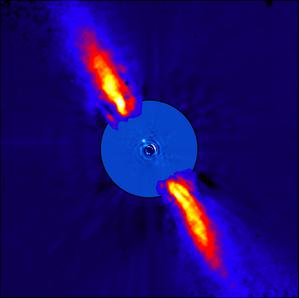Glossarbegriffe: Adaptive Optik
Description: Wenn du nachts nach oben schaust, siehst du vielleicht die Sterne funkeln. Das liegt daran, dass die Luft in der Erdatmosphäre immer in Bewegung ist. Durchquert das Licht eines Sterns eine Region mit Turbulenzen, wird es deshalb unterschiedlich stark abgelenkt. Deshalb ist das, was wir am Himmel sehen, nicht ein einziger gleichmäßiger Lichtpunkt für jeden Stern, sondern eine tanzende, sich ständig verändernde, verzerrte Folge von Punkten. Für Astronomen bedeutet das Funkeln, dass sie Himmelsobjekte nicht so detailliert abbilden können, wie es ihre großen erdgebundenen Teleskope sonst eigentlich könnten. Die adaptive Optik ist eine Möglichkeit, diesen Effekt abzuschwächen. Mit Hilfe eines echten Sterns oder eines mit einem Laser projizierten "künstlichen Sterns" überwacht ein System der adaptiven Optik ("AO") die atmosphärischen Verzerrungen in Echtzeit. Das in das Teleskop eintretende Licht wird auf einen verformbaren Spiegel gelenkt. Dieser Spiegel wird von einem Computer gesteuert und kontinuierlich verformt, um der atmosphärischen Verzerrung entgegenzuwirken.
Zugehörige Glossarbegriffe:
See this term in other languages
Term and definition status: The original definition of this term in English have been approved by a research astronomer and a teacher The translation of this term and its definition is still awaiting approval
The OAE Multilingual Glossary is a project of the IAU Office of Astronomy for Education (OAE) in collaboration with the IAU Office of Astronomy Outreach (OAO). The terms and definitions were chosen, written and reviewed by a collective effort from the OAE, the OAE Centers and Nodes, the OAE National Astronomy Education Coordinators (NAECs) and other volunteers. You can find a full list of credits here. All glossary terms and their definitions are released under a Creative Commons CC BY-4.0 license and should be credited to "IAU OAE".
Zugehörige Medien
beta Pictoris b
Bildnachweis: ESO/A.-M. Lagrange et al. credit link
License: CC-BY-4.0 Creative Commons Namensnennung 4.0 International (CC BY 4.0) icons
ESO's Very Large Telescope (VLT) at Paranal Observatory with a lunar halo
Bildnachweis: Juan Carlos Muñoz-Mateos/ESO credit link
License: CC-BY-4.0 Creative Commons Namensnennung 4.0 International (CC BY 4.0) icons










